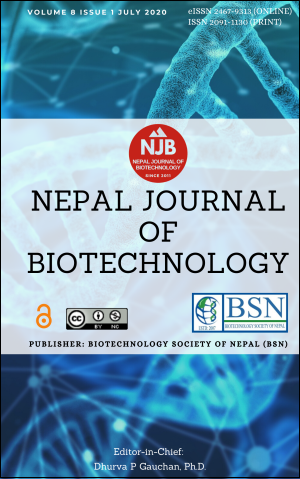Genetic Diversity in Finger Millet Landraces revealed by RAPD and SSR Markers
DOI:
https://doi.org/10.3126/njb.v8i1.30204Keywords:
Finger millet landraces, DNA finger print, genetic divesity, DNA markerAbstract
Genetic diversity assessment is the preliminary work for development of variety and conservation of diversity. Finger millet is a very important crop in Nepal however, its genetic potential has not been fully utilized. Genetic diversity was assessed in forty landraces of finger millet using 9 RAPD and 5 SSR markers. These landraces were collected from Kaski and Dhading districts. None of single primers of these RAPD and SSR could separate all 40 landraces. The average number of bands were 6.33 and 7.8 per RAPD and SSR primers respectively. Mean polymorphism information content was of 0.314 for RAPD and 0.37 for SSR. Primer OPA-4 produced the highest number of bands and the lowest numbers of bands were produced by OPA-16. Among the SSR primers, SSR-06 produced the highest number of polymorphic bands and UGEP-53 produced the lowest bands. RAPD based dendrogram has generated four clusters and SSR based dendrogram has generated two clusters. In both dendrogram and principal component analyses, Purbeli landrace was found unique locating separately in the cluster and scatter plot. Nei's genetic distance produced by RAPD and SSR primers was similar that is 0.327 by RAPD and 0.296 by SSR markers. Genetic distance produced by SSR markers was higher than distance produced by RAPD marker. These landraces were from two districts and therefore have shown intermediate diversity. These molecular marker-based findings should would be more useful if we could link with agromorphological traits. Inclusion of large number of landraces collected from different areas are required to get higher level diversity in addition to associate genetic diversity with geographical sites. Groupings of these landraces could be useful for selecting landraces in breeding program as well as planning conservation program.
Downloads
Downloads
Published
How to Cite
Issue
Section
License
Copyright Notice:
The manuscript submitted to NJB must be an original contribution, not previously published and should not be under consideration for publication elsewhere. When the manuscript is accepted for publication, the authors agree to automatically transfer the copyright of the article to the publisher. It should grant permission to any third party, in advance and in perpetuity, the right to use, reproduce or disseminate your article, according to the NJB copyright and license agreement.
Authors transfer copyright to the publisher as part of a journal publishing agreement but have the rights to: Share their article for Personal Use, Internal Institutional Use and Scholarly Sharing purposes, with the NJB applies the Creative Commons Attribution-NonCommercial CC BY-NC license to all the works we publish after Jun 2020 (Before it was CC BY-NC-ND). Under this license, authors agree to make articles legally available for reuse, without permission or fees, for virtually any non-commercial purpose. Anyone may remix, adapt, and build upon your work non-commercially, and although their new works must also acknowledge you and be non-commercial, they don’t have to license their derivative works on the same terms. More details on CC BY-NC refer to its Licence Deed and Legal Code.






